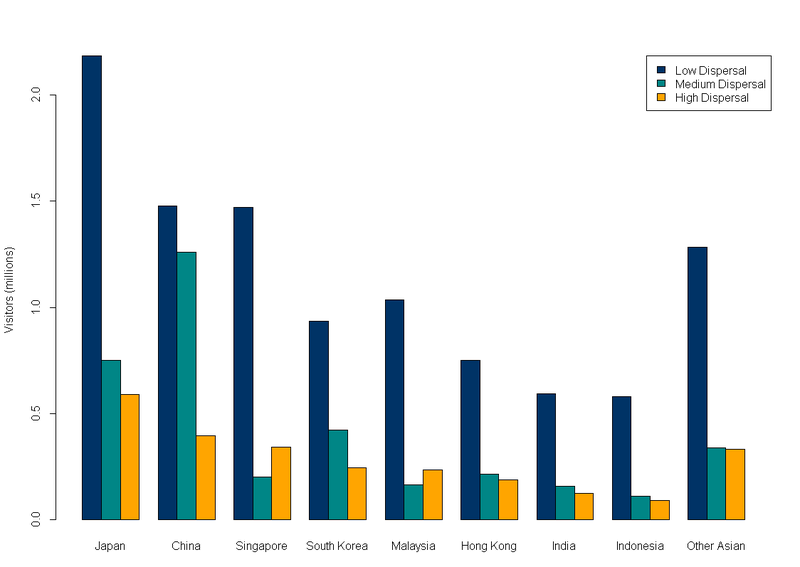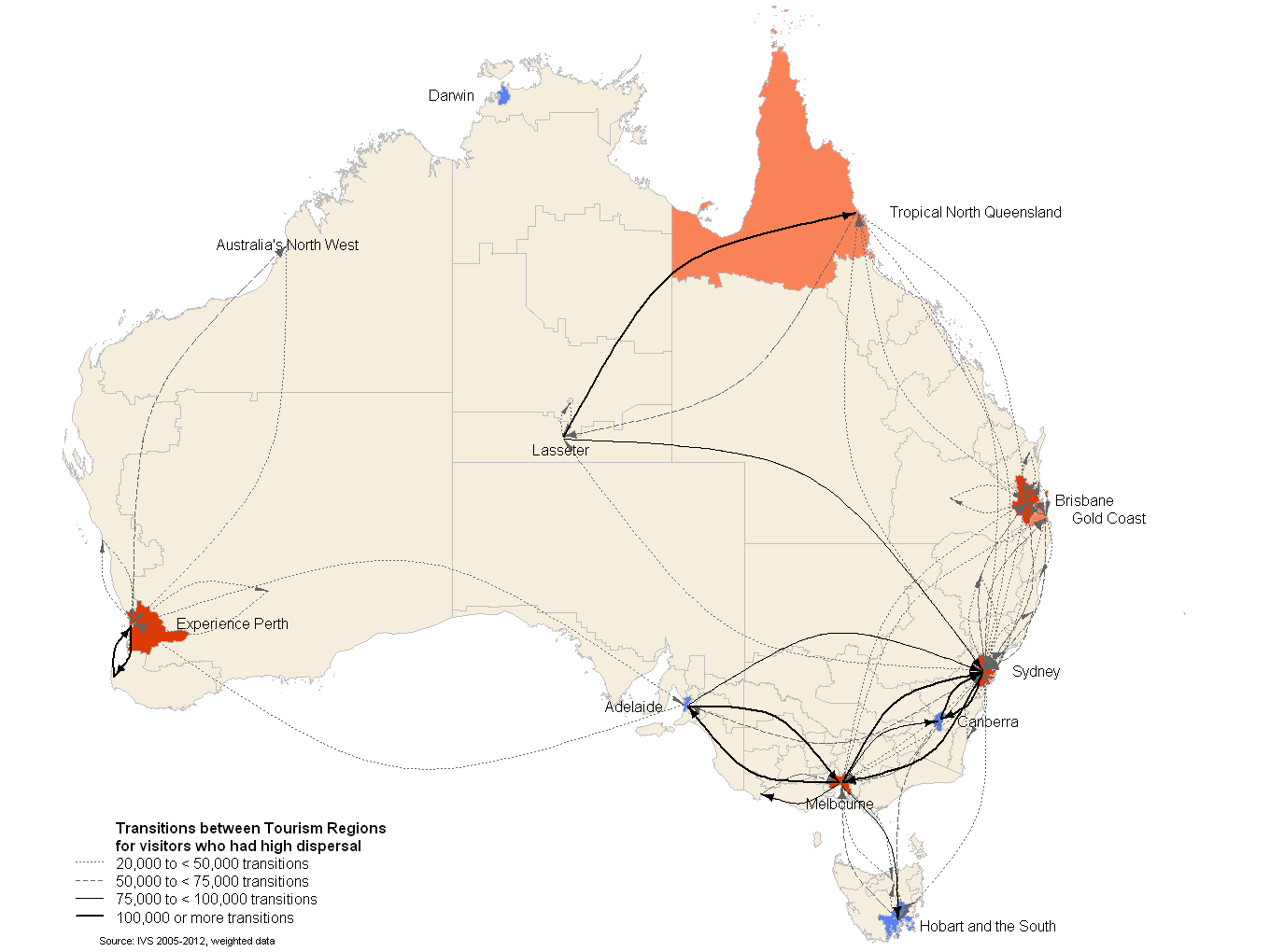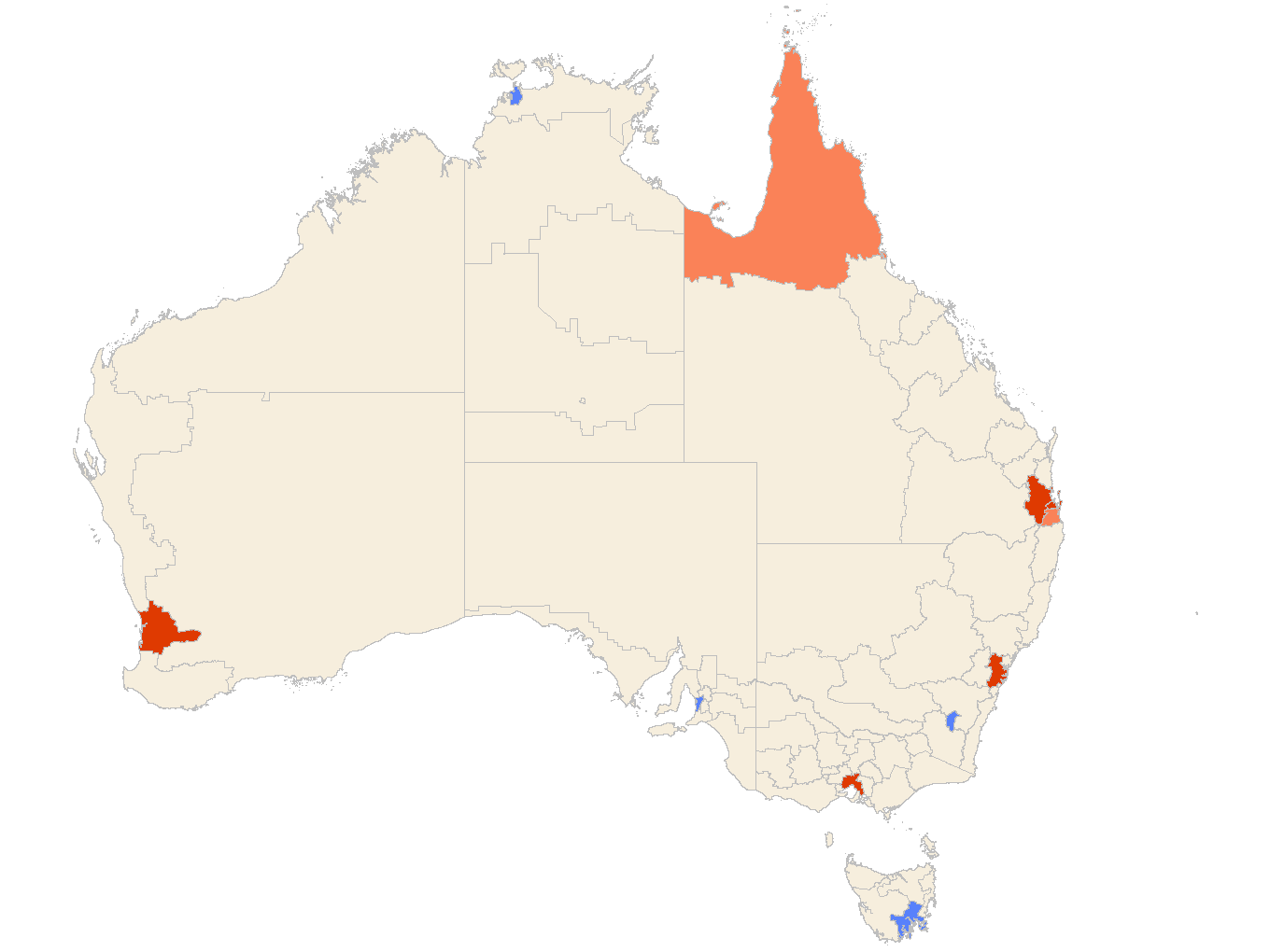Dispersal of Asian Visitors to Australia
Overview
The Problem:
Tourism Research Australia wanted to know "where do visitors from Asian countries of residence go?"
The Data Analysis Australia Approach:
- To investigate the high dispersal class (visitors who went to multiple places and outside of the major tourism regions) using maps and cartograms.
The Result:
- This investigation showed that even very short trips can be highly dispersed. Many of the regions visited by those with high dispersal are typically on the eastern seaboard centres and in locations where the infrastructure is set up to support such trips.
Background

Dispersal relates to spread, and in the context of tourism it relates to where people go. One itinerary may be considered more highly dispersed if it visits more locations than another, or potentially if it visits places off the beaten track rather than popular tourist regions. Understanding dispersal is valuable as tourism can be a major employer in regional areas.
Tourism Research Australia was interested in the dispersal of tourists from Asian countries of residence, as this segment of the market is growing and little was known about the dispersal of these visitors. Data Analysis Australia used Tourism Research Australia’s International Visitor Survey (IVS) data to investigate dispersal in this market.
Data
The IVS has been running since the early 1970’s and is the longest continuously running tourism survey in Australia. The core questionnaire collects detailed information on the visitor’s itinerary, with key items being locations of overnight stays, length of overnight stays, purpose of visits, accommodation types used, travel modes used and trip activities undertaken. Visitors to Australia are sampled on departure through face-to-face interviews in the departure lounges of major international airports. Data Analysis Australia considered data from approximately 140,000 Asian visitors collected over the eight years of 2005 to 2012.
For each stopover respondents were asked where they stayed and this location was geo-coded to a tourism region. Each tourism region was classified by Data Analysis Australia into one of three types:
- major tourism region – the four capital cities (Sydney, Melbourne, Brisbane and Perth) and two other well-known tourism regions (Tropical North Queensland and the Gold Coast);
- other capital cities; or
- regional.
Defining Three Dispersal Classes
Dispersal relates to how many locations were visited and the types of regions visited. Visitors were classified into three dispersal classes (High, Medium and Low) based on a principal components analysis. The variables placed into the analysis were based on numbers of stopovers, stays (any number of consecutive nights spent within a single tourism region) and nights in each type of region.
The low dispersal class is the largest, with 62% of visits from Asian countries of residence having low dispersal, the medium dispersal class has 22% of visits, with the majority of the visits being short, and the high dispersal class is the smallest of the classes. Those in the high dispersal class visit multiple places and visit regions outside the major tourism regions.
While this analysis aggregates the Asian countries, the first figure highlights the number of visitors in each of the three dispersal categories by country. China has a substantial number of visitors in the medium dispersal category compared to other Asian countries of residence and Japan has the largest number of visits in the low dispersal category.
Investigating the High Dispersal Class
This Case Study highlights our findings for the high dispersal class.

The map displays all two-step transitions, that is, all occurrences of a visitor reporting moving between each pair of possible locations. The arrows show direction of the transition and the thickness of the arrows shows how many visitors made this transition over the eight year period. The major tourism regions are in orange (darker shades for the capital cities), other capital cities are in blue and other regions are shaded beige.
For the high dispersal class many visitors transition between Melbourne and the neighbouring capital cities, Sydney and Adelaide. There were also many visitors who transitioned between Tropical North Queensland to Lasseter and therefore most likely visited Uluru. In addition to these popular transitions, there were also substantial numbers of visitors heading into other parts of regional Australia including Australia's North West and many of the tourism regions on the east coast.

A cartogram was used to display the number of stays in each region for the period of investigation. Cartograms are maps which have been distorted to display areas proportional to a measure of interest. For example, a cartogram representing population distorts the area so that a larger population density increases the relative size of that area. The cartogram below shows Australia distorted to represent the number of stays by the high dispersal group, and demonstrates that the high dispersal class spent the majority of their stays in the major tourism regions (Sydney, Melbourne, Brisbane, Perth, Gold Coast and Tropical North Queensland), however these visitors also stayed in other capital cities (Hobart, Adelaide, Canberra and Darwin) and in regional regions. Many of the stays in regional areas are in regions adjacent to a major tourism region or other capital cities with one notable exception, Lasseter (the tourism region with popular destination Uluru).
Conclusions
This approach yielded valuable insights about visitors from Asian countries of residence. This investigation showed that even very short trips can be highly dispersed. Many of the regions visited by those with high dispersal are typically on the eastern seaboard centres and in locations where the infrastructure is set up to support such trips. Only a small proportion of such trips involved venturing into regional areas. Hence while dispersal is often seen as a means of spreading the economic benefits of tourism across the community and particularly to regional areas, at present, this effect is limited.
September 2014
